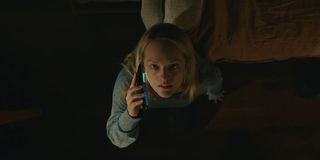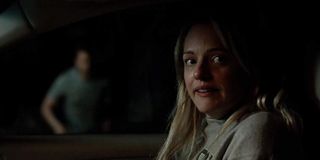5 Things Future Horror Movie Remakes Can Learn From The Invisible Man

SPOILER WARNING: The following article contains spoilers to The Invisible Man. If you have not seen the film, we recommend you do before you see something you do not want to see yet.
The Dark Universe may be dead, but the horror movies are not and Leigh Whannell’s The Invisible Man is the latest film to hold a candle to that. Despite technically being a remake Universal’s classic 1933 monster movie based on H.G. Wells’ novel about an unseeable villain, the Australian writer and director’s take brings the classic concept in a whole new direction, beyond simple modernization.
Why do we not see more updates on classic horror films like this: that pay tribute to the original by a more unique means? Because it is clear that we have not seen the last horror films, among other styles, being recycled, maybe it is time that we move on from simply remaking or rebooting, but instead start reinterpreting.
For this thankful process to go into effect, it is time for Hollywood’s horror “auteurs” to take note on how to remake a movie and actually become respected as a result instead of forever ridiculed for defacing a classic. With The Invisible Man being the most recent example of this rarity, I will use it as an example of what future horror remakes could learn from.

Changing The Point Of View Keeps The Material Interesting
The 1933 iteration of The Invisible Man is told from the perspective of a scientist driven to madness over his invisibility: a plotline mirrored by most films that borrow from the same concept, such as 2000’s Hollow Man. Instead of telling the story through the titular character’s eyes, Leigh Whannell’s film puts the victim, Elisabeth Moss’ Cecelia Kass, in the spotlight - a brilliant move that not only makes unseeable threat all the more unsettling, but allows for refreshing storytelling opportunities.
I will even go as far as using Rob Zombie’s 2007 version of Halloween as an example of this (just with the reverse effect, of course) for how he makes Michael Myers the main focus of the film and makes the villain an unexpected figure of empathy by shedding light on his terrible childhood. He even doubles down on this idea in the remake’s 2009 follow-up by making the typical hero, Dr. Loomis (Malcolm McDowell), a more despicable character hoping to profit off of tragedy with a tell-all book about the Myers Murders. Whether or not you agreed with Zombie’s vision or execution of his remake, you have to admit, like Leigh Whannell’s protagonist role reversal in The Invisible Man, it is a method rooted in ambition to tell a new kind of story.

Plots Based On Real-World Issues Help The Audience Relate To The Story
Before the concept of the unseen antagonist is even revealed in The Invisible Man, we are already on the edge of our seats rooting for Elisabeth Moss’ heroine, Cecelia Kass, to successfully escape her abusive marriage with Dr. Adrian Griffin (Oliver Jackson-Cohen). Then, once it becomes apparent to Cecelia that her supposed late husband has found a way to haunt her without being seen, people fail to take her pleas seriously.
CINEMABLEND NEWSLETTER
Your Daily Blend of Entertainment News
While it is understandable for people to distrust that a man assumed dead would be stalking his estranged wife, the plot point’s representation of women whose cries for help have been met with doubt paired with the theme of domestic abuse helps viewers to better identify with Cecelia and invoke empathy for her. Furthermore, it grounds The Invisible Man to the real world more than than most science-fiction thriller tend to be. Which brings me to my next point…

The More Realistic The Threat, The Scarier It Is
The goal of a horror film is, essentially, to convince the audience to buy into the terror - an especially tricky task when dealing with the supernatural, which 1933’s The Invisible Man (while claiming to be based in science) heavily borders on. However, the antagonist in Leigh Whannell’s film achieves invisibility with technology that actually exists and, well, there is just no denying how unsettling that is.
Dr. Adrian Griffin’s suit, which uses the developed but still unperfected cloaking technology, makes his reign of unseen terror a frightening possibility that would have never had the same effect had he just been, say, a ghost (which I honestly thought might have been the route they were going, initially). For the same reason why the culture clash nightmare of Midsommar gives people the creeps about cults or Stephen Soderbergh’s Contagion makes you more mindful to wash your hands, The Invisible Man’s refreshing plausibility has you checking if there really is no one in the empty seat next to you.

Jump Scares Aren't The Only Way To Shock The Audience
I do not know about you, but I am done with jump scares. By that, I do not mean that they scare me too much, but quite the opposite. There is nothing satisfying about the “fright” you get from an empty, uneventful passage of time followed by a loud noise and disturbing image. Thankfully, Leigh Whannell understands that.
Instead of preparing the audience for the next big shock, Leigh Whannell keeps them completely unprepared and in constant, anxious anticipation before the moment that I hesitate to call a “jump scare,” which I would say actually serves as the end of a sort of “prologue” before the real terror has yet to happen in The Invisible Man. For instance, in the scene when Cecelia is meeting her sister, Emily (Harriet Dyer), in a restaurant, the shock of the unseen assailant slitting Emily’s throat before placing the knife in Cecelia’s hands is not nearly as horrifying as what comes after: the immediate realization that Cecelia will never be able to escape her stalker’s wrath now that he has framed her for own sister’s murder. Unrelenting tension that envelopes into a jolt of abrupt and unexpected terror followed by pure dread is a horror tactic I would love to see trending.

Above All, Copy-Paste Never Gets The Grade
With all the things that Leigh Whannell does to make The Invisible Man feel original, the most important is that he did just that: he kept it original. He could have just as easily copied the original film’s screenplay into his own words and turned it in as such, but that sort of method is far too infuriatingly common and frustratingly unoriginal.
For instance, in 1998, Gus Van Sant remade Alfred Hitchcock’s 1960 thriller Psycho, but gave the infamously lambasted film no reason to justify its existence because it is shot-for-shot, exactly the same as the original. On the other side of that coin, in 1982, John Carpenter remade the 1951 monster movie The Thing from Another World as a paranoia-driven nightmare about a chameleonic organism that takes the form of whatever creature it consumes, which is entirely different story that allows the film to stand on its own from the original.
Like John Carpenter did with The Thing, but unlike what Gus Van Sant did with Psycho, Leigh Whannell does not treat his version of The Invisible Man as a remake, but uses the concept as a means to create something new. If you ask me, that should always be the goal when it comes to remakes, no matter the genre.
Be sure to check back for more news and updates on Leight Whannell's The Invisible Man or other forthcoming remakes from the genre here on CinemaBlend.

Jason Wiese writes feature stories for CinemaBlend. His occupation results from years dreaming of a filmmaking career, settling on a "professional film fan" career, studying journalism at Lindenwood University in St. Charles, MO (where he served as Culture Editor for its student-run print and online publications), and a brief stint of reviewing movies for fun. He would later continue that side-hustle of film criticism on TikTok (@wiesewisdom), where he posts videos on a semi-weekly basis. Look for his name in almost any article about Batman.
Most Popular





